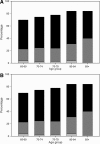Vitamin D deficiency in older men
- PMID: 19174492
- PMCID: PMC2682464
- DOI: 10.1210/jc.2008-1784
Vitamin D deficiency in older men
Abstract
Context: Vitamin D deficiency is not adequately evaluated in older men.
Objective: The aim of the study was to determine the prevalence of vitamin D deficiency and identify risk factors for its occurrence.
Design and setting: We conducted a cross-sectional evaluation of 1606 older men in the general community who were enrolled in the Osteoporotic Fractures in Men Study.
Participants: A randomly selected subcohort of a large population of men from six U.S. communities participated in the study.
Main outcome measures: Serum concentrations of 25-hydroxyvitamin D(2) [25(OH)D(2)] and 25(OH)D(3) were measured using mass spectrometry.
Results: Deficiency [25(OH)D <20 ng/ml] was present in 26%, and insufficiency (<30 ng/ml) was present in 72%. Deficiency was particularly common among men during the winter and spring (especially in the northern communities) and in the oldest and more obese men. For instance, in Caucasian men in winter or spring who were >80 yr old, did not engage in lawn/garden work, and had a body mass index greater than 25 kg/m(2) and vitamin D intake below 400 IU/d, the prevalence of vitamin D deficiency was 86%. 25(OH)D(2) levels were present in a small fraction of men and accounted for a low proportion of total 25(OH)D levels. The use of vitamin D supplements was reported by 58% of men, but supplement use had a small effect on total 25(OH)D levels and, despite supplement use, low levels remained frequent.
Conclusions: Vitamin D deficiency is common in older men and is especially prevalent in obese, sedentary men living at higher latitudes. Use of vitamin D supplements at levels reported here did not result in adequate vitamin D nutrition.
Figures
Comment in
-
MrOs is D-ficient.J Clin Endocrinol Metab. 2009 Apr;94(4):1092-3. doi: 10.1210/jc.2009-0388. J Clin Endocrinol Metab. 2009. PMID: 19349475 No abstract available.
References
-
- DeLuca HF 2004 Overview of general physiologic features and functions of vitamin D. Am J Clin Nutr 80:1689S–1696S - PubMed
-
- Holick MF 2006 High prevalence of vitamin D inadequacy and implications for health. Mayo Clin Proc 81:353–373 - PubMed
-
- Holick MF 2007 Vitamin D deficiency. N Engl J Med 357:266–281 - PubMed
-
- Dawson-Hughs B, Bischoff-Ferrari HA 2007 Therapy of osteoporosis with calcium and vitamin D. J Bone Miner Res 65:501–506 - PubMed
-
- Bischoff-Ferrari HA, Willett WC, Wong JB, Giovannucci E, Dietrich T, Dawson-Hughes B 2005 Fracture prevention with vitamin D supplementation: a meta-analysis of randomized controlled trials. JAMA 293:2257–2264 - PubMed
Publication types
MeSH terms
Substances
Grants and funding
- U01AG18197/AG/NIA NIH HHS/United States
- U01 AR45647/AR/NIAMS NIH HHS/United States
- U01 AR45614/AR/NIAMS NIH HHS/United States
- U01 AR045654/AR/NIAMS NIH HHS/United States
- U01-AG027810/AG/NIA NIH HHS/United States
- U01 AR045583/AR/NIAMS NIH HHS/United States
- U01 AG042140/AG/NIA NIH HHS/United States
- U01AR45632/AR/NIAMS NIH HHS/United States
- U01 AR45583/AR/NIAMS NIH HHS/United States
- U01 AR045632/AR/NIAMS NIH HHS/United States
- U01 AR045614/AR/NIAMS NIH HHS/United States
- U01 AR45654/AR/NIAMS NIH HHS/United States
- U01 AR045647/AR/NIAMS NIH HHS/United States
- U01 AR45580/AR/NIAMS NIH HHS/United States
- U01 AG027810/AG/NIA NIH HHS/United States
- UL1 RR024140/RR/NCRR NIH HHS/United States
- U01 AR045580/AR/NIAMS NIH HHS/United States
- U01 AG018197/AG/NIA NIH HHS/United States
LinkOut - more resources
Full Text Sources
Other Literature Sources
Medical



